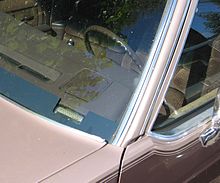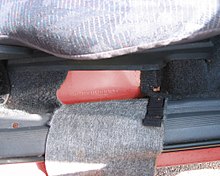
A | B | C | D | E | F | G | H | CH | I | J | K | L | M | N | O | P | Q | R | S | T | U | V | W | X | Y | Z | 0 | 1 | 2 | 3 | 4 | 5 | 6 | 7 | 8 | 9




A vehicle identification number (VIN; also called a chassis number or frame number) is a unique code, including a serial number, used by the automotive industry to identify individual motor vehicles, towed vehicles, motorcycles, scooters and mopeds, as defined by the International Organization for Standardization in ISO 3779 (content and structure) and ISO 4030 (location and attachment).[1]
There are vehicle history services in several countries that help potential car owners use VINs to find vehicles that are defective or have been written off.
History
VINs were first used in 1954 in the United States.[2] From 1954 to 1981, there was no accepted standard for these numbers, so different manufacturers and even divisions within a manufacturer used different formats. By 1966, GM had settled on a 13-digit VIN, and standardized its VIN format across its divisions in 1972.
In 1981, the National Highway Traffic Safety Administration of the United States standardized the format.[2] It required all on-road vehicles sold to contain a 17-character VIN, which does not include the letters O (o), I (i), and Q (q) (to avoid confusion with numerals 0, 1, and 9).
After the introduction of the ISO norm, the manufacturers which produced vehicles for the American market very quickly adjusted to this standard. The ISO introduced recommendations for applying the VIN standard and its structure, and the VIN was also used in Europe. However, the sets of information contained in it were introduced gradually. For example, Volkswagen started to encode bigger chunks of information during 1995–1997, and the control digit during 2009–2015 for selected models from the group. The VIN control digit is also used, although not in all brand-models. In the European vehicles, it can be found e.g. in Audi A1.[3]
Classification
There are at least four competing standards used to calculate the VIN.
- FMVSS 115, Part 565: Used in United States and Canada[4]
- ISO 3779: Used in Europe and many other parts of the world
- SAE J853: Very similar to the ISO standard
- ADR 61/2 used in Australia, referring to ISO 3779 and 3780[5]
Components
Modern VINs are based on two related standards, originally issued by the International Organization for Standardization (ISO) in 1979 and 1980: ISO 3779[6] and ISO 3780,[7] respectively. Compatible but different implementations of these ISO standards have been adopted by the European Union and the United States.[8]
The VIN comprises the following sections:
| Standard | 1 | 2 | 3 | 4 | 5 | 6 | 7 | 8 | 9 | 10 | 11 | 12 | 13 | 14 | 15 | 16 | 17 | ||
|---|---|---|---|---|---|---|---|---|---|---|---|---|---|---|---|---|---|---|---|
| ISO 3779 | World manufacturer identifier | Vehicle descriptor section | Vehicle identifier section | ||||||||||||||||
| European Union[9]
more than 500 vehicles/year |
World manufacturer identifier | Indication of "the general characteristics of the vehicle" | Indication that provides "clear identification of a particular vehicle" | ||||||||||||||||
| European Union[9]
500 or fewer vehicles/year |
World manufacturer identifier | 9 | Indication of "the general characteristics of the vehicle" | Indication that provides "clear identification of a particular vehicle" | |||||||||||||||
| North America
more than 2,000 vehicles/year |
World manufacturer identifier | Vehicle attributes | Check digit | Model year | Plant code | Sequential number | |||||||||||||
| North America
2,000 or fewer vehicles/year |
World manufacturer identifier | 9 | Vehicle attributes | Check digit | Model year | Plant code | Manufacturer identifier | Sequential number | |||||||||||

World manufacturer identifier
The first three characters uniquely identify the manufacturer of the vehicle using the world manufacturer identifier or WMI code. A manufacturer who builds fewer than 1,000 vehicles per year uses a 9 as the third digit, and the 12th, 13th and 14th position of the VIN for a second part of the identification. Some manufacturers use the third character as a code for a vehicle category (e.g., bus or truck), a division within a manufacturer, or both. For example, within 1G (assigned to General Motors in the United States), 1G1 represents Chevrolet passenger cars; 1G2, Pontiac passenger cars; and 1GC, Chevrolet trucks.
The Society of Automotive Engineers (SAE) in the US assigns WMIs to countries and manufacturers.[10]
The first character of the WMI is typically the region in which the manufacturer is located although there are exceptions e.g. the WMI 7SA was assigned to Tesla Inc. in the United States in 2021.[11] In practice, each is assigned to a country of manufacture, although in Europe the country where the continental headquarters is located can assign the WMI to all vehicles produced in that region (Example: Opel/Vauxhall cars whether produced in Germany, Spain, the United Kingdom or Poland carry a WMI of W0L because Adam Opel AG is based in Rüsselsheim, Germany).
In the notation below, assume that letters precede numbers and that zero is the last number. For example, 8X–82 denotes the range 8X, 8Y, 8Z, 81, 82, excluding 80.[10]
Country or region codes
| A–C = Africa | J–R = Asia | S–Z = Europe | 1–5, 7 = North America | 6 = Oceania | 8–9 = South America |
|---|---|---|---|---|---|
|
AA-AH South Africa |
J Japan |
SA-SM United Kingdom |
1, 4, 5 or 7 United States |
6 Australia |
8A-8E Argentina |
Vehicle descriptor section
The fourth to ninth positions in the VIN are the vehicle descriptor section or VDS. This is used, according to local regulations, to identify the vehicle type, and may include information on the automobile platform used, the model, and the body style. Each manufacturer has a unique system for using this field. Most manufacturers since the 1980s have used the eighth digit to identify the engine type whenever there is more than one engine choice for the vehicle. Example: for the 2007 Chevrolet Corvette, U is for a 6.0-liter V8 engine, and E is for a 7.0-liter V8.
North American check digits
One element that is inconsistent is the use of position nine as a check digit, compulsory for vehicles in North America and China, but not Europe.
Vehicle identifier section
The 10th to 17th positions are used as the vehicle identifier section or VIS. This is used by the manufacturer to identify the individual vehicle in question. This may include information on options installed or engine and transmission choices, but often is a simple sequential number.
Model year encoding
The North American implementation of the VIS uses the 10th digit to encode the model year of the vehicle. Besides the three letters that are not allowed in the VIN itself (I, O and Q), the letters U and Z and the digit 0 are not used for the model year code. Outside North America the 10th digit is usually 0.
The year 1980 was encoded by some manufacturers, especially General Motors and Chrysler, as "A" (since the 17-digit VIN was not mandatory until 1981, and the "A" or zero was in the manufacturer's pre-1981 placement in the VIN), yet Ford and AMC still used a zero for 1980. Subsequent years increment through the allowed letters, so that "Y" represents the year 2000. 2001 to 2009 are encoded as the digits 1 to 9, and subsequent years are encoded as "A", "B", "C", etc.
| Code | Year | Code | Year | Code | Year | Code | Year | Code | Year | Code | Year | |||||
|---|---|---|---|---|---|---|---|---|---|---|---|---|---|---|---|---|
| A | 1980 | L | 1990 | Y | 2000 | A | 2010 | L | 2020 | Y | 2030 | |||||
| B | 1981 | M | 1991 | 1 | 2001 | B | 2011 | M | 2021 | 1 | 2031 | |||||
| C | 1982 | N | 1992 | 2 | 2002 | C | 2012 | N | 2022 | 2 | 2032 | |||||
| D | 1983 | P | 1993 | 3 | 2003 | D | 2013 | P | 2023 | 3 | 2033 | |||||
| E | 1984 | R | 1994 | 4 | 2004 | E | 2014 | R | 2024 | 4 | 2034 | |||||
| F | 1985 | S | 1995 | 5 | 2005 | F | 2015 | S | 2025 | 5 | 2035 | |||||
| G | 1986 | T | 1996 | 6 | 2006 | G | 2016 | T | 2026 | 6 | 2036 | |||||
| H | 1987 | V | 1997 | 7 | 2007 | H | 2017 | V | 2027 | 7 | 2037 | |||||
| J | 1988 | Zdroj:https://en.wikipedia.org?pojem=Vehicle_identification_number
